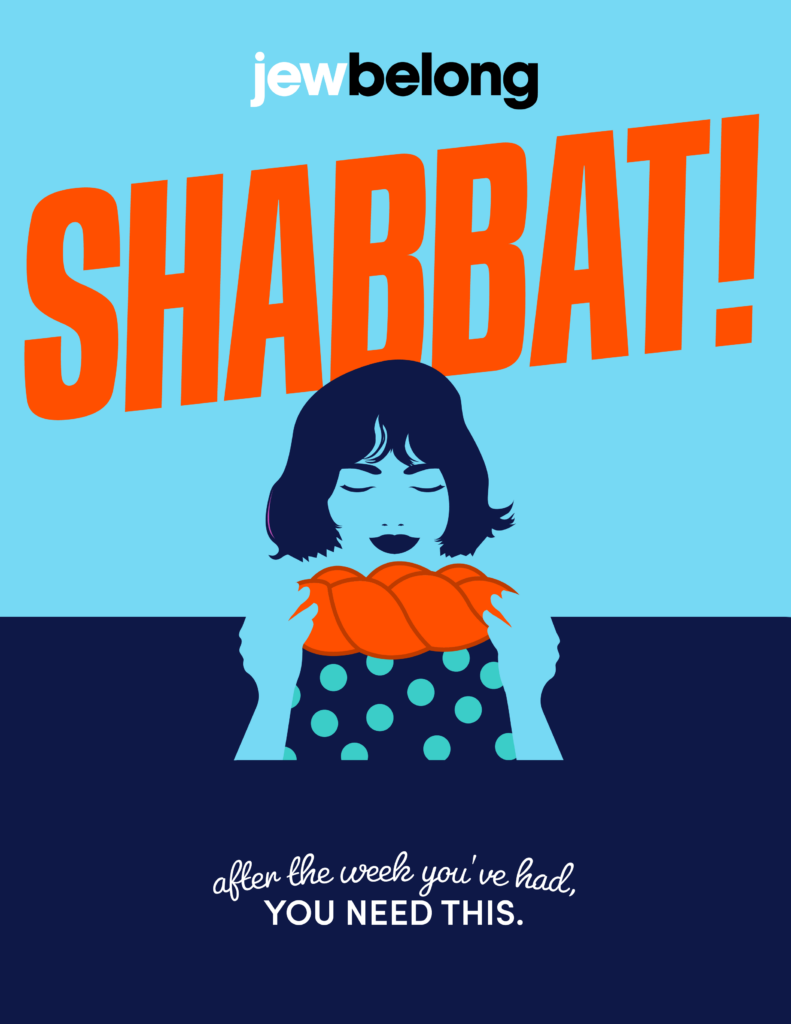Shabbat
FRIDAY NIGHT LIGHTS without the concussion
Swear to God, if we had a nickel for every time we heard, “I wish I had done Shabbat with my kids when they were growing up,” we’d have… well, a shit ton of nickels. The reason is that Shabbat is a perfect time for a restful dinner after a busy week. Shabbat comes with easy-to-follow instructions and somehow between the candles, the bread and the wine, it creates a sacred space. This might sound corny, but we don’t care, cause it’s true.

first off,
THERE ARE NO SHABBAT POLICE

Some people like to bake a challah or set the table with the good china (is that still a thing?) but that’s not for everyone. Do NOT, we repeat, do not get overwhelmed by the idea that your Shabbat has to be fancy. The traditional Shabbat celebration starts with four blessings before dinner: candles, wine, challah and one for the people that we love. We made this checklist to level out your expectations. You can do this!

The JewBelong Shabbat Checklist
Challah (for the challah blessing). No challah? Use whatever bread you have in the house. No bread? Use a pretzel!
Wine and kiddush cup (for the blessing over the wine). Or, use grape juice or a juice box. Hell, use a margarita. (If you haven’t figured this out yet, we are desperately trying to emphasize that you can’t do it wrong. The only way to do it wrong is to not do it.)
Candles (for the candle blessing).
Dinner: You can go old-school and roast a chicken, but maybe you feel like Pad Thai instead? Fabulous! Busy week? Kick Shabbat off with a martini.
Readings: We have lots to choose from, but this blessing for kids, and this blessing for interfaith homes are extra special. Our hilarious skits, written by Lin Manuel Miranda, are the perfect way to get everyone involved. (JK. We wrote them.)
Yes, Friday is fabulous because it is the end of the work week, but Shabbat makes it more than that. And, if one week your Shabbat isn’t as inspirational or warm as you like, just wait seven days and try again!
What's up with the Torah?
It’s made of parchment, and we’re not supposed to touch it because the natural oil in our hands can harm these often very old scrolls. Instead, there’s a cool pointer called a yad – it’s shaped like a little hand, because yad is hand in Hebrew – and the person reading the Torah uses the yad to keep his or her place. This is easier said than done because the writing is super small and the Torah is in Hebrew, with no vowels, which makes it tough to read.
Reading the Torah is, well, complicated. The Torah is chock full of laws and stories. It takes a year to read the whole thing. We start on Rosh Hashanah and finish on Simchat Torah. Every year. Same book. So, if you had a book to get through every year, and you knew that on Saturday Shabbat services they would read one section, you’d split up the book into 52 sections. One per week and let it rip. Which is almost how it works with the Torah. The catch is that there are 54 sections instead of 52, and each section is pretty long, so most synagogues split each section into three parts, and cycle through the Torah every three years.
how to shabbat
The point of Shabbat is to rest. Resting isn’t lazy; it’s restorative and gets you ready for the week to come. Staying away from the mall and other hectic places makes that easier. If you want to go big, you can follow stricter rules, like not driving, carrying money, emailing or watching TV. Some people observe Shabbat rules until sundown on Saturday. But for most of us, it’s not practical, and honestly, we don’t want to. The important thing is to set Friday nights apart and make them special. Try one of JewBelong’s skits! Or go to a synagogue. Friday night services often include singing, are on the shorter side, and you might really enjoy it. (Pro tip: Saturday morning services tend to be longer.)
saturday services
Aliyah
havdalah
Then of course, there's
the shabbat meal
Like we said, whether you roast a chicken, or order pad thai, what matters is that you are doing it! Below are some of the crucial prayers for your Shabbat dinner.

Lighting the Shabbat Candles
Lighting Shabbat candles is one of the oldest Jewish traditions. It’s also one of the most beautiful. Here is an explanation of not only how, but some of the beautiful traditions behind it.
We light at least two candles on Shabbat. The number two symbolizes the two mitzvot (commandment) of Shabbat which are Remember the day of Shabbat and Observe to make it holy. Many families light more than two candles… some light one for each of the parents and then one candle for each child. No matter how many candles are lit, the next step is to circle your hands across the top of the candles three times, washing the light toward yourself and then cover your eyes as you recite the blessing. Everyone can do this, it doesn’t just need to be the person who is actually lighting the candles. The reason we sweep our hands over the light towards ourselves is that true rest is the ingathering of our energy. For six days of the week, we are outward beings, investing ourselves in the world around us. During the workweek, we are pulled in all directions, and our frantic activities can drain our souls. On Shabbat we pull back, holding our energy in to regain focus and balance. After expending our powers outward all week, we physically sweep the light toward ourselves to draw our energy back inward to its source. The reason we sweep our hands three times is that on Shabbat our retreat from our busy life happens on three levels: action, speech and thought.
We also close our eyes before reciting the prayer and open them when we are finished. The reason for this is that it is overcoming a loophole of observant Judaism. Basically, a blessing is supposed to happen before you do the thing. Like you make the blessing over the bread and then you eat it. But you are not allowed to light a match on Shabbat, so you wouldn’t light the candle once the prayer is said. Tricky, right? So… the way it’s often done to solve this problem is that the candle lighter, (traditionally the woman of the home, but you be you) closes her eyes while she is saying the blessing so that when she opens her eyes she is enjoying the light for the first time. So, in a way the blessing precedes the act of enjoying the light. Another way to look at this is that closing our eyes is an additional tool to help draw our energy back to ourselves which is what we are supposed to do on Shabbat. The lighting of the candles is often the first part of bringing in Shabbat, so when we open our eyes and see the light, we are truly in Shabbat time and space.
Baruch atah Adonai, Eloheinu melech ha-olam, asher kid’shanu b’mitzvotav, v’tzivanu l’had lik neir shel Shabbat. Amen.
Blessed are You, God, Spirit of the Universe who has made us holy with Your mitzvot and commanded us to light the Shabbat light. Amen.
HaMotzi Blessing Over the Bread
This blessing is traditionally made over a challah, a sweet braided bread. If you don’t have a challah, use different bread, or even a cracker or pizza crust. Making the blessing is more important than the actual bread.
Baruch atah Adonai, Eloheinu melech ha-olam, hamotzi lechem min ha-aretz. Amen.
Blessed are You, God, Spirit of the Universe, who brings forth bread from the earth. Amen.
Kiddush Blessing Over the Wine
The Kiddush is the blessing over the wine. Traditionally, a silver goblet is used but you can use whatever you want. Even if just one person makes the blessing, everyone is supposed to partake in the wine (or grape juice), so you should fill everyone’s glass before the blessing is made. There are different customs about whether to stand or sit while receiving Kiddush. Sometimes everyone stands, sometimes just the person reciting stands, sometimes everyone sits. You decide.
Baruch atah Adonai, Eloheinu melech ha-olam, borei p’ree hagafen. Amen.
Baruch atah Adonai, Eloheinu melech ha-olam,
Asher qid’shavu b’mitzvotayv v’ratzah vanu,
V’shabat qadsho b’ahavah u’v’ratzon hinchilanu,
zikaron l’ma’aseh v’reishit,
Kiy hu yom t’chilah l’miqra ‘ey qodesh,
zeikher liytziyat mitzrayim,
Kiy vanu vacharta v’otanu qidashta mikol ha’amiym’,
V’shabat qadsh’kha b’ahavah u’v’ratzon hin’chal’tanu,
Baruch atah Adonai, m’qadesh ha-shabat. Amen
And there was evening and there was morning, the sixth day. The heavens and the earth were finished. And on the seventh day, God ended all the work and rested. And God blessed the seventh day.
Blessed are You, God, Spirit of the Universe, who creates the fruit of the vine. Amen.
Blessed are You, who sanctifies us with commandments and has been pleased with us. You have lovingly and willingly given us Your holy Shabbat as an inheritance in memory of creation. The Shabbat is the first among our holy days and remembrance of our exodus from Egypt. Indeed, You have chosen us and willingly and lovingly given us Your holy Shabbat for an inheritance. Blessed are You, who sanctifies the Shabbat. Amen.
Grace After the Meal
A lovely way to end your meal. This short blessing gives thanks for the food you’ve eaten and for feeling satisfied as a result.
Baruch atah Adonai, Eloheinu melech ha’olam hazan et ha’olam kulo b’tuvo b’chen b’chesed w’rachamin. Hu noten lechem l’chol basar ki l’olam chasdo. Uv’tuvo hagadol tamid lo chasar lanu v’al yech’sar lanu mason l’olam va’ed. Ba’avur sh’mo hagadol ki hu zan um’farnes lakol umetiv lakol umechin mazon l’chol b’riyotav asher bara. Baruch atah Adonai hazan et hakol.
Blessed are You, God, Spirit of the Universe. You are the origin of love and compassion, the source of bread for all.
We praise God, source of food for everyone. As it says in the Torah: When you have eaten and are satisfied, give praise to God who has given you this good earth. We praise God for the earth and for its sustenance. Renew our spiritual center in our time. May the source of peace grant peace to us, to the Jewish people, and to the entire world.
-Author Unknown
Peek Inside our
free booklet
Our booklets can take you from zero to hero! They are full of relatable, occasionally funny, and always meaningful resources to connect you to Judaism.
we know you're looking for those
Shabbat prayers and blessings
Shabbat is the ultimate way to pause your chaotic week, connect with your spiritual side, and maybe impress your bubbe. These rituals aren’t just ancient words—they’re opportunities to reflect, find gratitude, and bring a little peace to your soul. Whether you’re praying solo or with loved ones, these moments have a way of grounding you in what truly matters.
Mi Shebeirach
The Mi Shebeirach is the most common and well-known Jewish blessing for healing. This blessing makes us cry, and not just sad-cry, especially when said in a group – it’s that powerful.
It’s most commonly said at synagogue on Shabbat. Many rabbis have a poignant ritual of looking very slowly across the congregation, making eye contact with those of us in the pews, giving the chance for those of us in the pews to say out loud the name of someone who needs healing. This is also lovely because it is one of those rituals that’s a real community-maker. For example, if you say your sister’s name during Mi Shebeirach, then hopefully after services, someone will come over to you and inquire about what’s wrong, not because they are being nosy, but because they are concerned about you. One of the most beautiful aspects of community is knowing when someone amongst them is in pain so that they can help if they are able.
The most common way to recite Mi Shebeirach is the one below. It was written by Debbie Friedman and is a beautiful song.
Mi shebeirach avoteinu
M’kor hab’racha l’imoteinu
May the source of strength,
Who blessed the ones before us,
Help us find the courage to make our lives a blessing,
and let us say, Amen.
Mi shebeirach imoteinu
M’kor habrachah l’avoteinu
Bless those in need of healing with r’fuah sh’leimah,
The renewal of body, the renewal of spirit,
And let us say, Amen.
Prayer For Couples
There is a very old blessing, called Eishet Chayil, generally translated as A Woman of Valor that is recited in many observant Jewish homes on Shabbat before the blessing over the wine. In this blessing, the husband recites the blessing to give honor to his wife. Sweet, right?
During the blessing he compares her to rubies and compliments the cleanliness of the house, and how well she sews curtains and bakes bread. While JewBelong is all for blessing or declaring love for one another as much as possible, Eishet Chayil is outdated and doesn’t resonate the way it did back in the shtetl. JewBelong’s modern version is a beautiful way for all couples to show appreciation to one another. Enjoy!
[Partner 1]
To you, my partner, I say: “Thank you.”
Thank you for being you, in all your flawed perfection
Thank you for sharing your heart and your life with me
For your laughter and your tears
Your strength and your struggles
Your certainty and your doubts
Thank you for growing with me and not away from me
For talking and for listening
For arguing and for making up
For seeing and being a light in the darkness
For all these things, I say: “Thank you.”
[Partner 2]
To you, my partner, I ask: “Please.”
Please see me as I am, in all my flawed perfection.
Please show me compassion and understanding
Through my breakdowns and breakthroughs
My triumphs and tribulations
My miracles and meltdowns
Please continue growing with me and not away from me
Seeing the goodness in my soul
The sincerity of my love
And my desire to continue building this life with you
For all these things, I ask: “Please.”
[Both Partners in Unison]
To you, I say: “Thank you.”
To you, I ask: “Please.”
To you, I pledge my love
And with God’s blessing, may we enjoy the best of times together. Amen.
-A JewBelong Original
Blessing To Our Friends And Family
Welcoming Shabbat as a group adds to the powerful experience of letting go of the past week and preparing for the week ahead. Plus, this reading is a great way to let friends know how much you appreciate them!
Here with you beside me, I feel so greatly blessed,
life’s joys can be better when shared with friends and family.
We thank you for being here.
Shabbat is here; it is a time to be together, a time to rest.
As we sit together, feel each others hands as a chain around the table,
we enjoy the feeling of starting our Shabbat together.
As a group, let us release the past week.
Release its joys as well as its sorrows.
The last week is now part of our own personal history.
May its lessons be well-learned.
Allow us to use this Shabbat to help us rest and prepare our mind and body for the week ahead, and may this Shabbat be filled with joy and peace.
-Adapted from Mah Tovu’s Rabbi Ken Chasen and Rabbi Yoshi Zweiback
Children's Blessings
This beautiful blessing is a favorite, especially for family Shabbats. It’s short and sweet, and your kids will appreciate it, even if they try to wiggle away at first.
Here with you beside me, I feel so greatly blessed.
This moment means much more than I can say.
A time to be together, a time for us to rest.
Shabbat is here.
The time has come to celebrate the day.
So I hold you close, my hands upon your head.
As I watch you growing, I smile through my tears;
Sometimes I wish you’d stay forever small.
But then I see you blossom,
And I befriend the passing years.
I love you now, I’ll love you then, I love to see it all.
So I lift my voice to offer you this prayer,
for every step along the road, I will be there.
-Adapted from Mah Tovu’s Rabbi Ken Chasen and Rabbi Yoshi Zweiback
This short reading asks for God’s blessing for our children, and calls on the strength of our ancestors to protect and guide them.
(FOR SONS) May God make you like Ephraim and Menasheh.
(FOR DAUGHTERS) May God make you like Sarah, Rebecca, Rachel, and Leah.
(FOR SONS AND DAUGHTERS) May God bless you and protect you.
May God’s presence shine on you and be good to you.
May God reach out to you tenderly and give you peace.
-Author Unknown